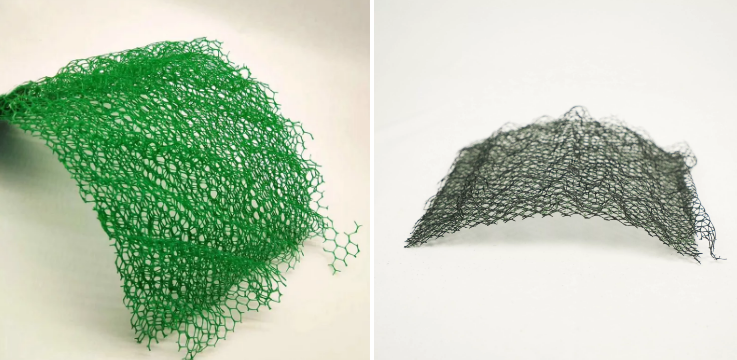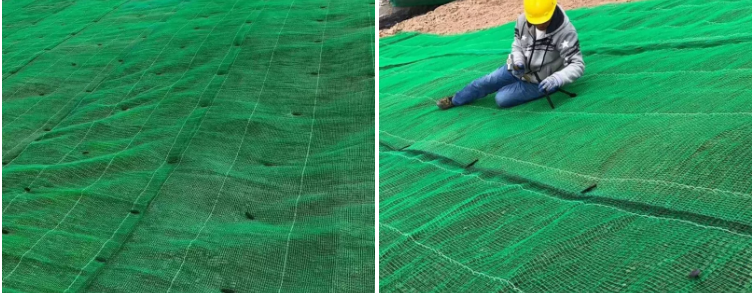Geogrid fabric is a type of geosynthetic material that is used in the construction of roads and other infrastructure projects to provide reinforcement and stability to soil and other materials. It is typically made from a synthetic material, such as polyester, and is designed to have high tensile strength and durability. When used in road construction, geogrid fabric is often placed in layers beneath the roadway to provide support and reduce the amount of settling that occurs over time. This can help to extend the life of the road and reduce maintenance costs. Geogrid fabric is also commonly used in the construction of retaining walls, slopes, and other earthworks projects where soil stability is a concern.

geotextile fabric for muddy roads
Geotextile fabric is a type of permeable, synthetic fabric that is often used in the construction of roads and other infrastructure projects to provide reinforcement and stability to soil and other materials. It is made from a variety of materials, including polypropylene and polyester, and is designed to have high tensile strength and durability. In the case of muddy roads, geotextile fabric can be used to improve the stability and strength of the road surface by providing a layer of reinforcement beneath the roadway. This can help to reduce the amount of settling that occurs over time and improve the overall durability of the road. Geotextile fabric can also be used to filter and separate different layers of soil and other materials, helping to improve the overall stability of the road surface.
The role and use of geotextile fabrics
Geotextile, also known as geotextile, is a permeable geosynthetic material made of synthetic fibers through needle punching or weaving. The finished product is cloth-like, generally 4-6 meters wide and 50-100 meters long. Geotextiles are divided into woven geotextiles and non-woven geotextiles. Geotextiles have excellent functions of filtration, drainage, isolation, reinforcement, anti-seepage, and protection. They are light in weight, high in tensile strength, good in permeability, high temperature resistance, freezing resistance, aging resistance, and corrosion resistance.
Geotextile Features:
- Utilize the good air permeability and water permeability of the geotextile to allow water to pass through, thereby effectively retaining the loss of sand and soil.
- Geotextile has good water conductivity, it can form a drainage channel inside the soil, and discharge excess liquid and gas in the soil structure.
- Use geotextiles to enhance the tensile strength and deformation resistance of the soil, enhance the stability of the building structure, and improve the quality of the soil.
- Effectively diffuse, transmit or decompose the concentrated stress to prevent the soil from being damaged by external forces.
- Prevent mixing between upper and lower layers of sand, soil and concrete.
- The mesh is not easy to block – the mesh structure formed by the amorphous fibrous tissue has strain and mobility.
- High water permeability – under the pressure of soil and water, it can still maintain good water permeability
- Corrosion resistance – made of polypropylene or polyester and other chemical fibers, acid and alkali resistance, no corrosion, no insects, anti-oxidation
- Simple construction – light weight, easy to use, simple construction

Geotextile application:
The product has excellent water permeability, filterability and durability, and can be widely used in railways, highways, sports halls, dams, hydraulic structures, tunnels, coastal tidal flats, reclamation, environmental protection and other projects.
The role of geotextile construction:
A. Reverse filter function, it can be used as a reverse filter layer for dams, river canals, coasts, concrete slopes, retaining walls, etc., allowing water or gas to pass through freely while preventing soil particles from passing through.
B. Isolation function, can be used to isolate railway ballast and roadbed, roadbed and soft foundation, airport and parking lot surface and foundation, and different dam materials, and separate soil sand and stone materials of two different particle sizes from the foundation or other buildings.
C. Reinforcement, used in highways, railways, earth-rock dams, breakwaters, airports, retaining wall backfills, slopes and other projects to distribute soil stress, prevent soil lateral movement, and improve soil stability.
D. Protective effect, used for embankment to prevent wind, wave, tide and rain erosion, and used for revetment, bottom protection, and prevention of soil erosion.
